The U.S. dairy herd will continue adjusting to market forces
- by Jerry Cessna
- 3/30/2015

U.S. milk cow numbers are projected to rise through 2018 as high milk prices and lower feed costs provide favorable returns to producers. Lower returns due in part to higher feed costs are expected to lead to year-to-year declines in cow numbers from 2020-24. At the same time, U.S. milk output per cow is projected to increase through the projection period, reflecting continued technological and genetic developments. Domestic commercial use of dairy products is expected to increase faster than the growth in U.S. population over the next decade. The demand for cheese is expected to rise due to greater consumption of prepared foods and increased away‑from-home eating, while the long-term decline in per capita consumption of fluid milk products is likely to continue. The United States is expected to expand exports of dairy products; commercial U.S. dairy exports are projected to increase steadily over the next decade, reaching record levels on both a fat and a skim-solids basis. Production increases in other major dairy exporting countries are expected to lag growth in global import demand, supporting a favorable outlook for U.S. dairy exports. This chart is based on the report, USDA Agricultural Projections to 2024.


